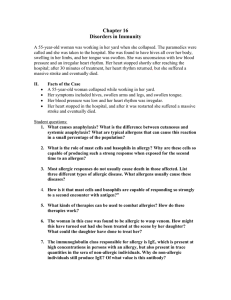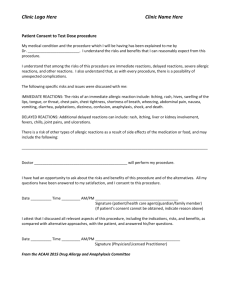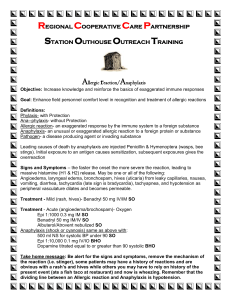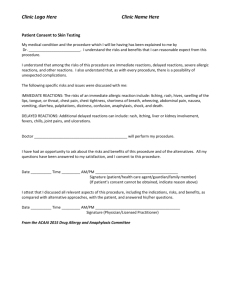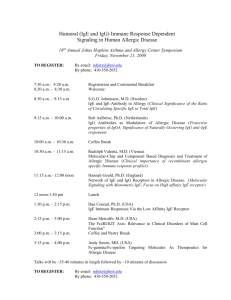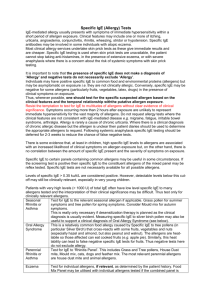Food Allergy 101
advertisement
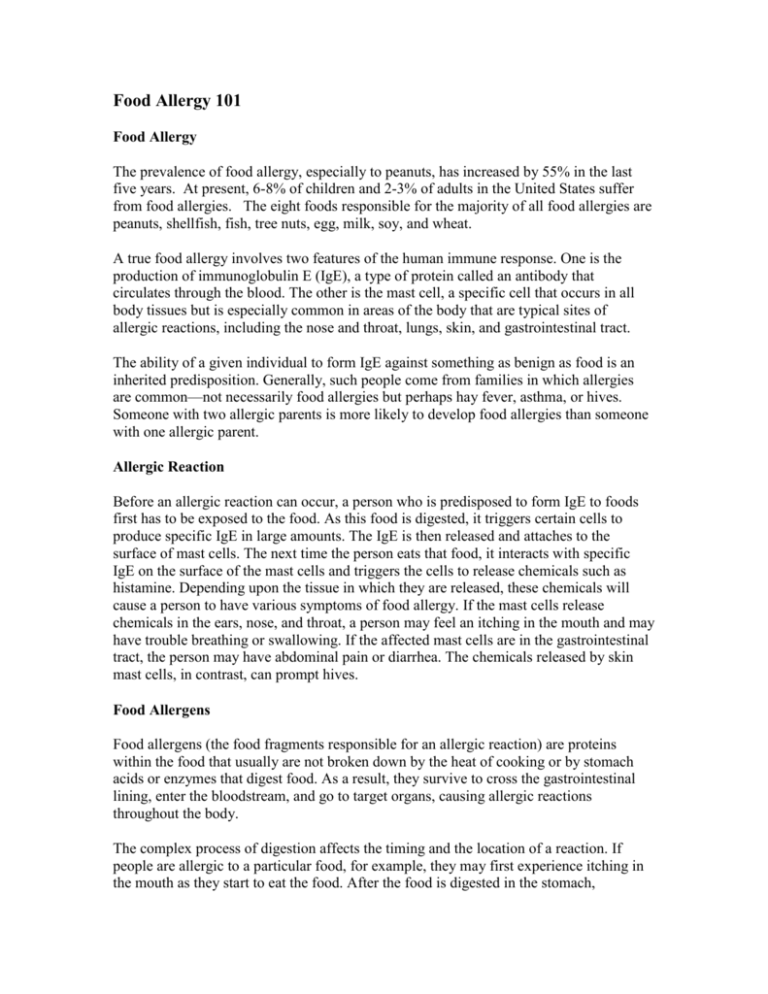
Food Allergy 101 Food Allergy The prevalence of food allergy, especially to peanuts, has increased by 55% in the last five years. At present, 6-8% of children and 2-3% of adults in the United States suffer from food allergies. The eight foods responsible for the majority of all food allergies are peanuts, shellfish, fish, tree nuts, egg, milk, soy, and wheat. A true food allergy involves two features of the human immune response. One is the production of immunoglobulin E (IgE), a type of protein called an antibody that circulates through the blood. The other is the mast cell, a specific cell that occurs in all body tissues but is especially common in areas of the body that are typical sites of allergic reactions, including the nose and throat, lungs, skin, and gastrointestinal tract. The ability of a given individual to form IgE against something as benign as food is an inherited predisposition. Generally, such people come from families in which allergies are common—not necessarily food allergies but perhaps hay fever, asthma, or hives. Someone with two allergic parents is more likely to develop food allergies than someone with one allergic parent. Allergic Reaction Before an allergic reaction can occur, a person who is predisposed to form IgE to foods first has to be exposed to the food. As this food is digested, it triggers certain cells to produce specific IgE in large amounts. The IgE is then released and attaches to the surface of mast cells. The next time the person eats that food, it interacts with specific IgE on the surface of the mast cells and triggers the cells to release chemicals such as histamine. Depending upon the tissue in which they are released, these chemicals will cause a person to have various symptoms of food allergy. If the mast cells release chemicals in the ears, nose, and throat, a person may feel an itching in the mouth and may have trouble breathing or swallowing. If the affected mast cells are in the gastrointestinal tract, the person may have abdominal pain or diarrhea. The chemicals released by skin mast cells, in contrast, can prompt hives. Food Allergens Food allergens (the food fragments responsible for an allergic reaction) are proteins within the food that usually are not broken down by the heat of cooking or by stomach acids or enzymes that digest food. As a result, they survive to cross the gastrointestinal lining, enter the bloodstream, and go to target organs, causing allergic reactions throughout the body. The complex process of digestion affects the timing and the location of a reaction. If people are allergic to a particular food, for example, they may first experience itching in the mouth as they start to eat the food. After the food is digested in the stomach, abdominal symptoms such as vomiting, diarrhea, or pain may start. When the food allergens enter and travel through the bloodstream, they can cause a drop in blood pressure. As the allergens reach the skin, they can induce hives or eczema, or when they reach the lungs, they may cause asthma. All of this takes place within a few minutes to an hour. Food Allergy Patterns In adults, the most common foods to cause allergic reactions include: shellfish such as shrimp, crayfish, lobster, and crab; peanuts, a legume that is one of the chief foods to cause severe anaphylaxis, a sudden drop in blood pressure that can be fatal if not treated quickly; tree nuts such as walnuts; fish; and eggs. In children, the pattern is somewhat different. The most common food allergens that cause problems in children are peanuts, eggs, and milk. Children may outgrow allergies to milk and eggs but are unlikely to outgrow an allergy to peanuts. Cross Reactivity If someone has a life-threatening reaction to a certain food, the doctor will counsel the patient to avoid similar foods that might trigger this reaction. For example, if someone has a history of allergy to shrimp, testing will usually show that the person is not only allergic to shrimp but also to crab, lobster, and crayfish as well. This is called crossreactivity. Another interesting example of cross-reactivity occurs in people who are highly sensitive to ragweed. During ragweed pollination season, these people sometimes find that when they try to eat melons, particularly cantaloupe, they have itching in their mouth and they simply cannot eat the melon. Similarly, people who have severe birch pollen allergy also may react to the peel of apples. This is called "oral allergy syndrome." Anaphylaxis Food-induced anaphylaxis is a form of immunoglobulin E (IgE) mediated hypersensitivity manifested by an abrupt onset of symptoms within minutes to hours of ingesting a food. The symptoms are the result of the generation and release of a variety of potent biologically active mediators and their combined effects on the skin, gastrointestinal tract, respiratory tract, and cardiovascular system. The majority of food anaphylactic reactions in the United States are the result of allergic reactions to peanuts, tree nuts, fish, or shellfish. An estimated 30,000 cases of foodinduced anaphylaxis occur each year, resulting in approximately 150-200 deaths. Symptoms of Anaphylaxis Symptoms of food anaphylaxis may develop within seconds to a few hours after the ingestion of a food allergen, with the vast majority of reactions developing within the first hour. The time of onset of symptoms, the sequence in which symptoms develop, and the severity of the symptoms vary from individual to individual and may even vary in the same individual during repeated episodes or in response to different foods. The first symptoms often involve the mouth and throat, and may include a tingling or burning sensation, a “metallic” taste, itching, and swelling of the lips, tongue, palate, and throat. Gastrointestinal symptoms frequently follow, including nausea, abdominal pain, vomiting, and diarrhea. Skin symptoms may include flushing, hives, and swelling. Skin symptoms may be absent in severe reactions. Respiratory symptoms often consist of a deep repetitive cough, wheezing, and difficulty breathing. Acute bronchospasm may occur, blocking the flow of air to the lungs. Cardiovascular symptoms may include lightheadedness, chest pain, heart palpitations, sudden decreases in blood pressure, and loss of consciousness. TABLE 1. Grading of Food-Induced Anaphylaxis According to Severity of Symptoms Grade Skin GI Tract Respiratory Tract Cardiovascular Neurological 1 Localized itching, Oral itching flushing, hives or "tingling," 2 Generalized itching, flushing, hives, swelling of the lips, face, or tongue Any of the above, nausea and/or vomiting Nasal congestion and/or sneezing 3 Any of the above Any of the above plus repetitive vomiting Nasal discharge, marked congestion, sensation of throat itching or tightness Rapid heart beat (increase >15 beats/min) Change in activity level plus anxiety 4 Any of the above Any of the above plus diarrhea Any of the above, hoarseness, "barky" cough, difficulty swallowing and/or breathing, wheezing, cyanosis Any of the above, irregular heartbeat and/or mild hypotension "Light headedness," feeling of "impending doom" 5 Any of the above Any of the above, loss of bowel control Any of the above, respiratory arrest Severe bradycardia Loss of and/or hypotension consciousness or cardiac arrest Change in activity level
